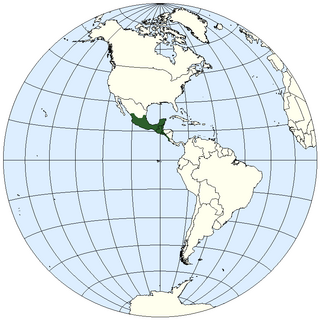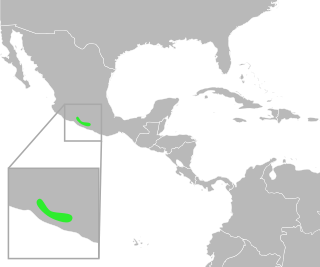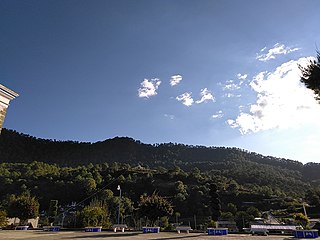| Tlapaneco River | |
|---|---|
 | |
 | |
| Location | |
| Country | Mexico |
The Tlapaneco River is a river located in southern Mexico. exactly in the state of Guerrero.
| Tlapaneco River | |
|---|---|
 | |
 | |
| Location | |
| Country | Mexico |
The Tlapaneco River is a river located in southern Mexico. exactly in the state of Guerrero.
The Tlapaneco River flows through the rockyland of Guerrero, a region having many mountains landscapes and valleys. It is part of the larger Balsas River Basin, which is one of the most important river systems in Mexico. It is a tributary of the Balsas River, which into the Pacific Ocean. The river originates from the highlands(High areas) near Tlapa de Comonfort City in the Mexican state of Guerrero.

Guerrero, officially the Free and Sovereign State of Guerrero, is one of the 32 states that compose the 32 Federal Entities of Mexico. It is divided into 81 municipalities. The state has a population of about 3.5 million people. It is located in southwest Mexico and is bordered by the states of Michoacán to the north and west, the State of Mexico and Morelos to the north, Puebla to the northeast and Oaxaca to the east. In addition to the capital city, Chilpancingo and the largest city Acapulco, other cities in Guerrero include Petatlán, Ciudad Altamirano, Taxco, Iguala, Ixtapa, and Zihuatanejo. Today, it is home to a number of indigenous communities, including the Nahuas, Mixtecs, Tlapanecs, Amuzgos, and formerly Cuitlatecs. It is also home to communities of Afro-Mexicans in the Costa Chica region.

The Sierra Madre del Sur is a mountain range in southern Mexico, extending 1,000 kilometres (620 mi) from southern Michoacán east through Guerrero, to the Isthmus of Tehuantepec in eastern Oaxaca.

Tixtla is a town and seat of the municipality of Tixtla de Guerrero in the Mexican state of Guerrero. The name is Nahuatl, and means either "maize dough" (masa) from textli; "our valley" from to ixtla; or "temple by the water" from teoixtlen'

Tehuacán is the second largest city in the Mexican state of Puebla, nestled in the southeast of the valley of Tehuacán, bordering the states of Oaxaca and Veracruz. The 2010 census reported a population of 248,716 in the city and 274,906 in the surrounding Tehuacán municipality, of which it serves as municipal seat. The municipality has an area of 390.36 km2 (150.72 sq mi).

The geography of Mesoamerica describes the geographic features of Mesoamerica, a culture area in the Americas inhabited by complex indigenous pre-Columbian cultures exhibiting a suite of shared and common cultural characteristics. Several well-known Mesoamerican cultures include the Olmec, Teotihuacan, the Maya, the Aztec and the Purépecha. Mesoamerica is often subdivided in a number of ways. One common method, albeit a broad and general classification, is to distinguish between the highlands and lowlands. Another way is to subdivide the region into sub-areas that generally correlate to either culture areas or specific physiographic regions.

The Supanecan or Tlapanecan languages are Tlapanec (Me'phaa) of Guerrero and the extinct Subtiaba of Nicaragua. The family was recognized in 1925 by Edward Sapir, who linked them to his Hokan proposal. However, they are the most recently recognized members of the Oto-Manguean language family, the relationship having been demonstrated in 1977 by Jorge Suárez. The Oto-Manguean affiliation of Tlapaneco-Subtiaba is supported by Kaufman (2016).

Incilius perplexus is a species of toad in the family Bufonidae. It is endemic to southern Mexico and found in the Tepalcatepec River basin in the state of Michoacán and western Balsas River basin in the state of Guerrero. Its natural habitats are seasonal tropical forests near streams. It breeds in pools. It is threatened by habitat loss caused by infrastructure development and agricultural expansion.

The Balsas dry forests is a tropical dry broadleaf forest ecoregion located in western and central Mexico.
Ixtcateopan de Cuauhtémoc is a municipality in the Mexican state of Guerrero. It is located in the parallel 18°25’ of north latitude and between the meridians 99°42’ and 99°51’ of west longitude. The distance between Ixcateopan and Chilpancingo, the capital of the state of Guerrero, is 180 km.
Cuajinicuilapa is a municipality in the Mexican state of Guerrero and is the southernmost municipality in Guerrero. The municipal seat lies at Cuajinicuilapa. The municipality covers an area of 857.1 km². In 2020, the municipality had a total population of 26,627, up from 25,537 in 2005.
The Atoyac River is a river of Mexico located in the state of Guerrero.
The Río del Oro is a river of southern Mexico. It is a tributary of the Balsas River, originating in the Sierra Madre del Sur of Guerrero state and flowing northwards to join the Balsas.

The Cutzamala River is a river of Mexico. It originates in the Trans-Mexican Volcanic Belt of Central Mexico in the state of Michoacán. Dams on the upper portion of river provide water to Mexico City, via an aqueduct over the mountains known as the Cutzamala System.

The Cupatitzio River is a river of Michoacán state in Southwestern Mexico.

The Sierra Madre del Sur pine–oak forests is a subtropical coniferous forest ecoregion in the Sierra Madre del Sur mountain range of southern Mexico.

The Balsas River is a major river of south-central Mexico.

The Mezcala culture is the name given to a Mesoamerican culture that was based in the southern Mexican state of Guerrero, in the upper Balsas River region. The culture is poorly understood but is believed to have developed during the Middle and Late Preclassic periods of Mesoamerican chronology, between 700 and 200 BC. The culture continued into the Classic period when it coexisted with the great metropolis of Teotihuacan.
General Juan N. Álvarez National Park is a national park and protected area located in Guerrero, Mexico. The park was established in 1964 and covers approximately 5.28 square kilometres (2.04 sq mi). The area is named after Juan Álvarez, a Mexican general and former president of Mexico.

The Sierra del Ajusco-Chichinauhtzin, also known as Serranía del Ajusco or Sierra de Chichinauhtzin, is a Mexican mountain range located between Mexico City and the states of Morelos and Mexico. It makes up the southern part of the mountain necklace that surrounds Mexico City. It is made up of more than one hundred volcanic cones, among which are: Tláloc, Chichinauhtzin (3,430 metres, Xitle (3,100 metres, Cerro Pelado (3,600 metres and Cuauhtzin (3,510 metres. Its maximum height is at the Cruz del Marqués peak on the Ajusco volcano.
The Sierra de Huautla is a mountain range and biosphere reserve in central Mexico. Located in southern Morelos, the Sierra de Huautla is a southern extension of the Trans-Mexican Volcanic Belt range into the Balsas Basin. The dry forests of Sierra are home to a diverse community of animals and plants, and the reserve's outstanding biodiversity is recognized by UNESCO.